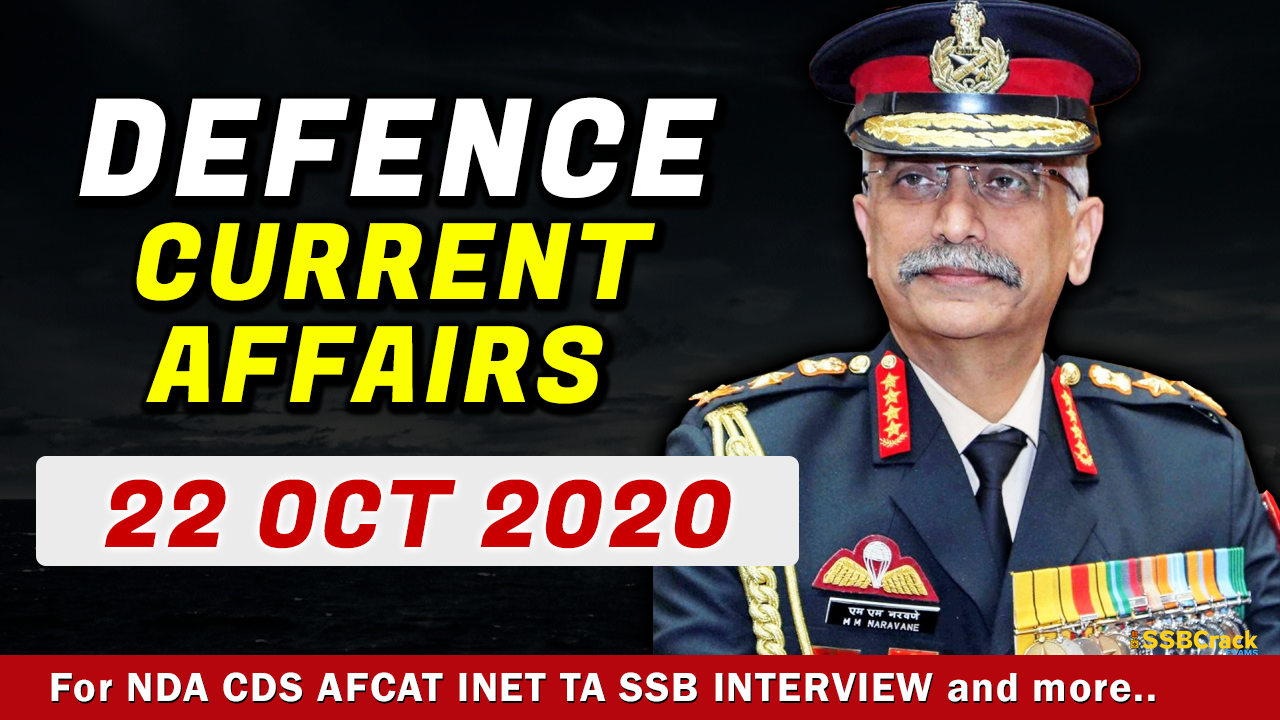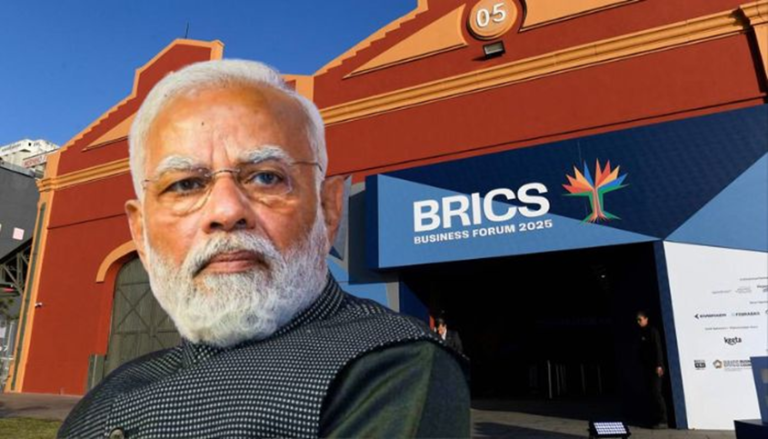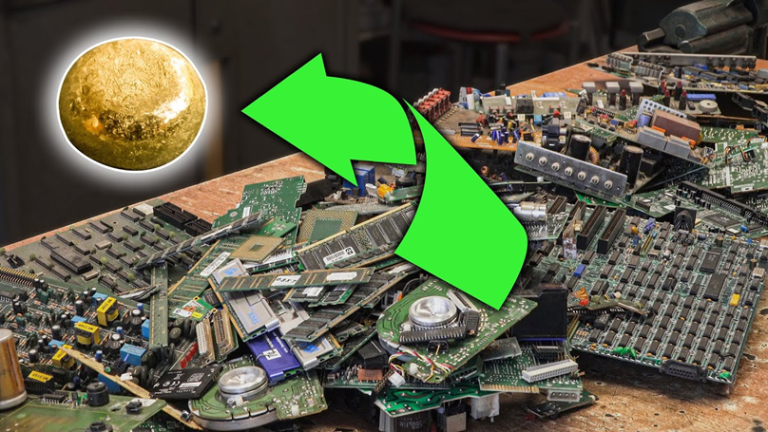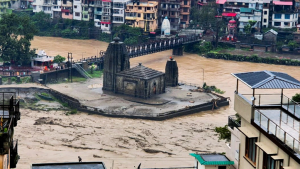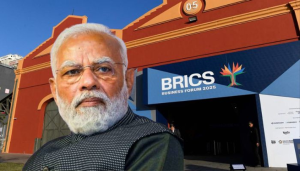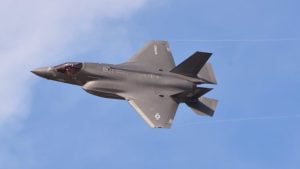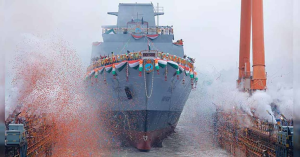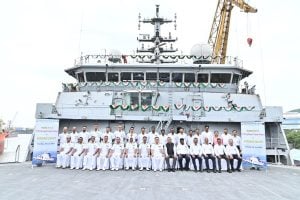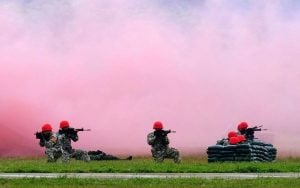Indigenously built ASW Corvette ‘INS Kavaratti’ Commissioned at Visakhapatnam Naval Dockyard
- The last of four indigenously built Anti-Submarine Warfare (ASW) stealth corvettes “INS Kavaratti” under Project 28 (Kamorta class) is commissioned into the Indian Navy by General Manoj Mukund Naravane, PVSM, AVSM, SM, VSM, ADC, Chief of the Army Staff at Naval Dockyard, Visakhapatnam on Thursday, 22 October 20.
- Touted as a potent Stealth ASW Corvette, Kavaratti is indigenously designed by the Indian Navy’s in-house organisation, Directorate of Naval Design(DND), and built by Garden Reach Shipbuilders & Engineers (GRSE), Kolkata, and portrays the growing capability of the Indian Navy, GRSE and the nation in becoming self-reliant through indigenization, thus, accentuating our national objective of “Atmanirbhar Bharat”.
- The ship has up to 90% indigenous content and the use of carbon composites for the superstructure is a commendable feat achieved in Indian shipbuilding. The ship’s weapons and sensors suite is predominantly indigenous and showcases the nation’s growing capability in this niche area.
- Kavaratti has a state-of-the-art weapons and sensor suite capable of detecting and prosecuting submarines. In addition to its anti-submarine warfare capability, the ship also has a credible self defence capability and good endurance for long-range deployments.
- It is noteworthy that the ship will be commissioned into the Navy as a combat-ready platform as the ship has completed sea trials of all the systems fitted onboard. It is a praiseworthy achievement in itself, taking into consideration the restrictions imposed due to ongoing COVID-19 pandemic during which she was delivered to the Navy. With the induction of Kavaratti into its fold, the Indian Navy’s preparedness will be enhanced.
- Kavaratti takes her name from erstwhile INS Kavaratti which was an Arnala class missile corvette. The older Kavaratti distinguished herself by operating in support of was Bangladesh’s liberation in 1971.
Indo-Tibetan Border Police deputes first officer to head eastern command along LAC
- The Indo-Tibetan Border Police (ITBP), which guards the LAC with China, has posted its first officer to head the newly-created Guwahati-based eastern command that oversees deployment of border battalions in that region. Additional Director General Amrit Mohan Prasad, posted at the ITBP headquarters, has been transferred and posted as the ADG of the eastern command, an order issued on Tuesday by the force said.
- The command overlooks ITBP battalions posted along the Line of Actual Control (LAC) with China in states like Arunachal Pradesh, Sikkim and Assam with frontiers at Itanagar (northeast) and Lucknow (east) and sector offices at Likabali, Tezpur, Dibrugarh, Gangtok, among others.
- The command in Assam’s capital Guwahati also supervises ITBP battalions deployed for anti-Naxal operations in Chhattisgarh.
- Some officers, sub-officers and administrative staff were earlier posted by the force to operationalise the command, but the posting of the top officer was delayed, official sources said.
- The mountain-warfare trained force had similarly posted an officer (in the Inspector General-rank) in June to head its western command located in Chandigarh that has control over battalions deployed along the LAC in Ladakh, Uttarakhand and Himachal Pradesh.
- The two ADG-rank headed commands were sanctioned by the Union government in October last year for better operational functioning of the about 35-38 battalions of the force deployed at the LAC, starting from Ladakh to Arunachal Pradesh along the eastern front.
- The ITBP posts at this icy front are located at altitudes ranging from 9,000-18,700 feet. Earlier, the border deployments of the force were headed by IG-rank officers at various frontier locations.
- The new commands will streamline operations, intelligence, deployment and administrative movements of ITBP personnel to the border regions and also bring better synergy with the Army that secures the LAC, a senior official had said earlier. India and China currently have an ongoing standoff between their militaries in the Ladakh region.
- The ITBP, with an estimated manpower of 90,000 personnel, had bolstered its presence all along the 3,488-km-long LAC post these developments.
- “The force is undertaking short and long patrols in the border areas, including with Army personnel, at some locations,” a senior officer said.
- Last year, the force was also sanctioned two more ADG posts after its cadre restructuring and Prasad, a 1989-batch Indian Police Service officer of the Odisha cadre, was deputed with the ITBP in August this year.
- The Centre has also promoted 1990-batch Uttar Pradesh cadre ITBP Inspector General Daljit Singh Chaudhary on Tuesday to the post of ADG.
- He has been posted as an ADG at the ITBP headquarters.
- The third ADG-rank officer will be from the ITBP officers’ cadre and the orders for promotion and appointment of the eligible officer are expected to be issued by the government soon, they said.
Why DRDO has conducted a flurry of missile tests
- Over the last one and half months, the Defence Research and Development Organisation (DRDO) has conducted at least 12 tests of missiles or systems for missiles belonging to a vast spectrum of ranges and purposes. Some more tests are said to be in the pipeline. These tests have taken place at the time when there is an ongoing stand-off between the Indian and Chinese forces along the Line of Actual Control (LAC) in the Ladakh region.
- A look at arguably one of the most action-packed times for the DRDO, what goes into conducting these tests, what its means in terms of strategic posturing in the context of the stand-off along the LAC, and how COVID-19 restrictions played a role in it.
What are the various tests that the DRDO conducted recently?
- On September 7, the DRDO successfully flight tested the Hypersonic Technology Demonstrator Vehicle (HSTDV), which is an unmanned scramjet vehicle with a capability to travel at six times the speed of sound. The flight test of the vehicle is looked at as a boost to the development of the systems built with hypersonic vehicles including both offensive and defensive hypersonic cruise missiles and also in the space sector. The test was conducted at the Dr APJ Abdul Kalam Launch Complex at Wheeler Island, off the coast of Odisha.
- On September 22, a flight test of Abhyas, a High-speed Expendable Aerial Target (HEAT), was conducted from the Integrated Test Range (ITR) Balasore in Odisha when two demonstrator vehicles were test flown. Abhyas has been developed to be used as a target for evaluation of various missile systems.
- In another test on September 22, the Laser-Guided Anti Tank Guided Missile (ATGM) was test fired from Main Battle Tank (MBT) Arjun at a field range in Maharashtra where it hit a target at a 3-km range. The test was repeated for a slightly longer range on October 1. Laser Guided ATGM is a boost to the Armoured Warfare capabilities.
- On September 24, a successful night flight test of nuclear capable Prithvi-II missile with a range of around 400 kilometres was tested at the ITR. The test was executed by the Strategic Forces Command of India and monitored by the DRDO and other defence forces.
- On September 30, BrahMos surface-to-surface supersonic Land-Attack Cruise Missile (LACM) featuring an indigenous booster and airframe section along with many other ‘Made in India’ sub-systems was flight tested from ITR. On October 17, the Naval version of the BrahMos was successfully test fired from Indian Navy’s indigenously-built stealth destroyer INS Chennai, hitting a target in the Arabian Sea.
- On October 3, DRDO tested another nuclear capable missile Shaurya, which is a land-based version of the Submarine Launched Ballistic Missile Sagarika or K-15 with a range of around 800 km.
- On October 5, DRDO tested the Supersonic Missile Assisted Release of Torpedo (SMART) system. It’s an indigenously developed mechanism by which the torpedo is launched from an existing supersonic missile system — by making complex modifications — which takes the torpedo to a much longer range than its own.
- On October 9, India’s first indigenous anti-radiation missile named Rudram, developed for the Air Force (IAF), was successfully flight tested from a Sukhoi-30 MKI fighter jet off the east coast.
- After the series of successful trials, a flight test of intermediate range cruise missile on October 12, reported a snag and had to be aborted.
- On October 19, the DRDO conducted a test of Stand-Off Anti Tank Missile (SANT) off the coast of Odisha.
| No. | Date of Testing | Details of the test | Launch Site |
| 1. | 07 September 2020 | Hypersonic Technology Demonstrator Vehicle (HSTDV), which is an unmanned scramjet vehicle with a capability to travel at six times the speed of sound | Dr APJ Abdul Kalam Launch Complex at Wheeler Island, off the coast of Odisha |
| 2. | 22 September 2020 | Laser-Guided Anti Tank Guided Missile (ATGM) was test fired from Main Battle Tank (MBT) Arjun that hit a target at 3 km. | A field range in Maharashtra |
| 3. | 22 September 2020 | Abhyas, a High-speed Expendable Aerial Target (HEAT) along with two demonstrator vehicles | Integrated Test Range (ITR) Balasore in Odisha |
| 4. | 24 September 2020 | Nuclear capable Prithvi-II missile with a range of around 400 kilometres tested by Strategic Forces Command of Indian Army along with DRDO | Integrated Test Range (ITR) Balasore in Odisha |
| 5. | 30 September 2020 | BrahMos surface-to-surface supersonic Land-Attack Cruise Missile (LACM) featuring an indigenous booster and airframe section along with many other ‘Made in India’ sub-systems | Integrated Test Range (ITR) Balasore in Odisha |
| 6. | 03 October 2020 | Another nuclear capable missile Shaurya, which is a land-based version of the Submarine Launched Ballistic Missile Sagarika or K-15 with a range of around 800 km. | Integrated Test Range (ITR) Balasore in Odisha |
| 7. | 05 October 2020 | Supersonic Missile Assisted Release of Torpedo (SMART) system | Integrated Test Range (ITR) Balasore in Odisha |
| 8. | 09 October 2020 | India’s first indigenous anti-radiation missile named Rudram, developed for the Air Force (IAF), was successfully flight tested from a Sukhoi-30 MKI fighter jet | Wheeler Island off the coast of Odisha |
| 9. | 17 October 2020 | Naval version of the BrahMos was successfully test fired from Indian Navy’s indigenously-built stealth destroyer INS Chennai hitting a target in the Arabian Sea | Arabian Sea |
| 10. | 19 October 2020 | Stand-Off Anti-Tank Missile (SANT) | Wheeler Island off the coast of Odisha |
| 11. | 22 October 2020 | Final trial of the DRDO-Developed Nag ATGM Anti-Tank Guided Missile with a warhead. | Pokhran field firing ranges in Rajasthan |
What goes behind these tests?
- Senior DRDO scientists have said this is arguably one of the highest numbers of tests in such a short span. A large spectrum of missiles of different purposes, types, ranges are currently being developed primarily for the three armed forces. Some of the systems are at their various stages of development where they undergo development trials, validation trials, user trials etc. Some others have been already inducted and undergoing upgrades or are tested for different parameters.
- A senior DRDO scientist, who has been part of such development projects, said the development of missiles, of any range, is a complex and elaborate process. Even before the firing tests, the numerous sub systems have to be tested separately, he said, adding there are failures and snags on the way. “The warheads, flight systems, guidance systems, softwares, electronics, communication systems, high energy fuels, various motors, stage separators in multi-stage missiles, all have to be tested. There are Standard Operating Procedures in place. In almost all the cases, missiles are developed in collaboration with various DRDO facilities. There are course corrections, user feedback that have to be incorporated.”
- Another scientist said the tests are part of a well-charted development process and most planned well in advance. “For these tests, particularly ones with long range systems, multiple clearances are required including those from the Ministry of Defence, Ministry of External Affairs and PMO. A Notice to Airmen — NOTAM is issued by the Airport Authority of India for the flight path of projectiles. In many cases, one more armed forces or the Strategic Forces Command are part of the tests. In the case of tests that are conducted off the coast, the Navy and Coast Guard are involved in the process,” he explained.
Reasons behind series of tests and the strategic posturing
- Senior DRDO office-bearers say the timing of this tests series is significant considering the present stand-off with China. However, one key reason behind so many tests being done back to back is the fact many of these tests, scheduled for earlier this year, had to be put on hold due to COVID restrictions, while preparations for them were all in place.
- “Because of the COVID lockdown, the movement of scientists from various DRDO facilities for the purposes of tests were put on hold even though these facilities were functioning as per the norms laid down from time to time. In the initial COVID period, we all were a little apprehensive of what was going to happen. But as the time passed, we all got used to the new normal. As the easing of travel restrictions started, the tests got the required push. In many cases, we were 80 to 90 per cent ready, just a go-ahead was needed.” said a senior DRDO scientist.
- The missiles tested during this period are crucial for land attack capability and some for Air and maritime security and testing them is a strong signal. At a time when there is a stand-off with China which also has rising interests in the strategically crucial Indian Ocean Region, strategic signalling of this volume ‘cannot happen without a deliberate push from the government even if the COVID factor is considered’ said a senior scientist. Officials said some more tests of the strategically important weapons systems are in the pipeline for at least a month ahead.
Trump administration and Russia near deal to freeze nuclear warheads, extend New START pact
- The United States and Russia edged toward an arms control deal Tuesday after Moscow agreed to a freeze on the number of nuclear warheads on each side and to extend the accord known as New START for one year.
- The breakthrough came days after the two sides appeared to have nearly given up on finding a compromise and as President Trump urges his aides to bring him foreign policy wins in the final stretch of the U.S. presidential campaign.
- Russia’s Foreign Ministry put forward the proposal Tuesday, and within hours, the State Department expressed gratitude for the offer and requested an immediate meeting of negotiators.
- “We appreciate the Russian Federation’s willingness to make progress on the issue of nuclear arms control,” State Department spokeswoman Morgan Ortagus said in a statement. “The United States is prepared to meet immediately to finalize a verifiable agreement. We expect Russia to empower its diplomats to do the same.”
- Negotiators would still need to work out a verification system and agree on the definition of a warhead, which are “not small details,” said Daryl Kimball, the executive director of the Arms Control Association.
- “It’s not a dramatic breakthrough by any means,” he added, “but it would avoid the total collapse of the U.S.-Russian arms control system and would give Washington and Moscow time to continue to engage in further complex and lengthy talks.”
- A warhead freeze was a condition demanded by the Trump administration, which on Friday rejected Russian President Vladimir Putin’s offer of a one-year extension of New START, a 10-year accord that places limits on the two countries’ nuclear warheads.
- Putin’s proposal Friday made no mention of a mutual freeze on nuclear stockpiles, suggesting instead a simple one-year extension of the treaty with no conditions while Moscow and Washington negotiate what comes next.
- U.S. national security adviser Robert C. O’Brien responded in a statement that the offer was a “non-starter,” adding, “We hope that Russia will re-evaluate its position before a costly arms race ensues.”
- Moscow seemingly acquiesced Tuesday. The Russian Foreign Ministry said in a statement that the country “proposes extending New START for one year, and at the same time, it stands ready, together with the U.S., to assume a political obligation on freezing a number of the nuclear warheads possessed by the parties for this period.”
- “This item can be put into effect strictly and exclusively with the understanding that the freezing of warheads would not involve any extra requirements on the part of the U.S.,” the statement continued. It added that if Washington agrees, then “the time bought by extending New START can be used for conducting comprehensive bilateral negotiations on future control over nuclear missile weapons.”
- The 2010 treaty, which expires in February, restricts the number of deployed strategic nuclear warheads and certain launch platforms. If the treaty is not extended or replaced, the world’s two biggest nuclear powers will return to an era without substantive restraints on their arsenals for the first time in decades. (START is an acronym for Strategic Arms Reduction Treaty.)
- The treaty includes a clause that allows the leaders of both nations to extend the agreement by five years without requiring ratification. Democratic presidential nominee Joe Biden has said he would agree to the five-year extension if elected. Putin has also said he would agree to the extension, and in an interview with state television this month he said Biden’s willingness to prolong New START “is a serious signal for our possible future interaction.”
- The Trump administration’s envoy for arms control, Marshall Billingslea, initially insisted that China participate in talks. He wanted any replacement treaty to include China and to encompass all of Russia’s nuclear weapons — not just the “strategic” weapons covered under New START but also Russia’s sizable stockpile of smaller, “tactical” nuclear weapons that fall outside the treaty. Billingslea also insisted that verification mechanisms for any follow-on treaty be strengthened.
- Russia rejected the demands, and China has refused to take part in negotiations.
- Trump then dispatched O’Brien to meet with his Russian counterpart, Nikolai Patrushev, early this month in Geneva.
- After that meeting and calls between Trump and Putin, the Trump administration thought an agreement in principle had been reached. Speaking last week at the Heritage Foundation, Billingslea said he hoped that the “gentleman’s agreement” would “percolate down through their system so that my counterpart hopefully will be authorized to negotiate.”
- “We’re ready to strike this deal. We could strike it tomorrow, in fact,” Billingslea said. “But Moscow is going to have to show the political will to do so as well.”
- Democrats welcomed the progress in the talks but urged the Trump administration to establish a mutual verification system and finalize an extension of New START.
- “It is in the national interest of the United States to extend the New START treaty as we continue dialogue with both Russia and China on key nuclear issues,” said Sen. Robert Menendez (N.J.), the top Democrat on the Senate Foreign Relations Committee. “The real impact of a freeze on the total number of nuclear warheads will be unclear unless the Trump administration can ensure Russia sticks to the agreement’s terms through robust verification mechanisms.”
Govt looking at ‘highly confidential’ China proposal to reduce tensions in Ladakh
- The Indian government is considering a proposal mooted by China to reduce tensions at the Line of Actual Control (LAC) even as the two armies maintain status quo in Ladakh.
- Sources in the defence and security establishment refused to give details about the proposal, saying it remains “highly confidential”. Asked if the proposal was about withdrawal of armoured elements and artillery from the LAC, the sources replied in the negative.
- They said the authorities are yet to take a final call on the proposal but “discussions are on. The Chinese did come out with a proposal during the last military-level talks held on 12 October. The proposal is being looked at,” said a source. “The matter is under consideration by the top hierarchy and is confidential. Similarly, we have also moved proposals for reducing tensions.”
- India and China remain locked in a standoff at Ladakh, months after tensions first began with Chinese incursions along the LAC. The two armies now look set to maintain forward deployment at the border through Ladakh’s bitter winter.
- There have been multiple rounds of diplomatic and military talks so far, but a solution is yet to be arrived at. The two countries are expected to hold the eighth round of military talks, but a date hasn’t been decided so far.
- External Affairs Minister S. Jaishankar had said last week that India and China are engaged in talks to resolve the border standoff, adding that what is going on is “something confidential”.
DRDO revisits manual for India’s ‘self-reliant’ vision, facilitate indigenous defence industry
- With China and Pakistan both on our nerves, putting up a two-pronged resistance requires a system to ensure India also has a self-reliant mechanism in place to meet the country’s defence demands.
- In line with this same thought, Union Defence Minister Rajnath Singh on Tuesday released the ‘Procurement Manual 2020’ for the Defence Research and Development Organisation (DRDO), India’s premier agency for military research and development (R&D).
- This has been aimed at promoting and encouraging even more participation by Indian industry, including start-ups and Micro, Small and Medium Enterprises, in R&D to help achieve self-reliance.
- “The new DRDO procurement manual will facilitate the indigenous defence industry by simplifying the processes and ensure their participation in design and development activities,” the Defence Minister said.
- He acknowledged the contribution of DRDO officials and the finance wing of the Defence Ministry in bringing out the revised manual.
- The procurement manual is expected to facilitate faster execution of R&D programmes and projects. The modified features of the manual will go a long way to facilitate participation of industry in various R&D projects.
- Bidding security declaration option for earnest money deposit, increasing threshold limit for advance payment, placing orders on second lowest bidder in case the first lowest bidder backs out – these are some of the salient features of the new manual, which will assist the industry in the speedy execution of projects.
- The other actions laid out in the manual are exemption of bid security and performance security up to Rs 10 lakh, no negotiations for commercial off-the-shelf items or services, wherever price discovery happens through market forces.
- “Performance security for service contracts is linked to the payment cycle instead of contract value. Procurement of stores from development partners, safeguarding free issue material through insurance cover instead of bank guarantee are the other facilitating measures adopted to help the industry,” the Defence Ministry said in a statement.
- Furthermore, the liquidated damage rate for development contracts has also been reduced. The delivery period extension process has been simplified for faster decision-making. Many of the internal procedures have been simplified further for faster engagement with industry. The previous procurement manual of the DRDO was last modified in 2016.
REVIEW QUESTIONS
- INS Kavaratti was commissioned under
- Project 26
- Project 27
- Project 28
- Project 29
ANSWER: C
- INS Kavaratti comes under which class of warships in Indian Navy?
- Arihant
- Kalvari
- Kamorta
- Vela
ANSWER: C
- INS Kavaratti is commissioned into the Indian Navy at which Naval Dockyard?
- Mumbai
- Goa
- Thiruvananthapuram
- Visakhapatnam
ANSWER: D
- INS Kavaratti is commissioned into the Indian Navy on
- 19 October 2020
- 20 October 2020
- 21 October 2020
- 22 October 2020
ANSWER: D
- India Today Successfully carried out the final trial of the DRDO-Developed Nag ATGM Anti-Tank Guided Missile with a warhead. The test was carried out at
- Pokhran field firing ranges in Rajasthan
- Field Firing ranges in Maharashtra
- Wheeler Island off the coast of Odisha
- Integrated Test Range (ITR), Odisha
ANSWER: A
- START Pact is between which two global nations?
- India and USA
- USA and USSR
- India and USSR
- France and USA
ANSWER: B


